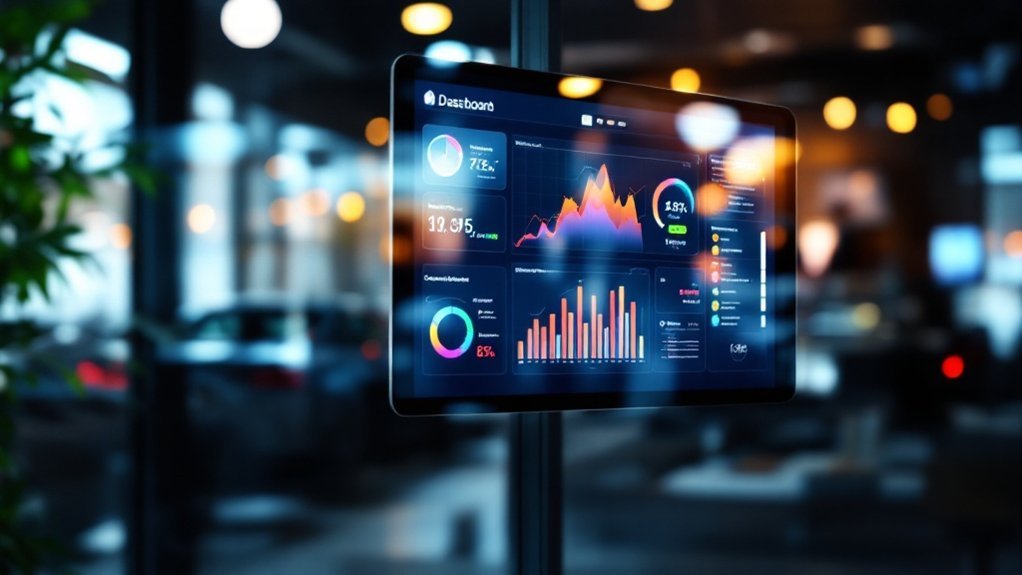You need five live KPIs that drive daily action: data capture quality, credit lead-to-deal conversion, time to credit decision and first contact, online-to-showroom show rate, and appointment performance plus be-back follow-up. Track email/text capture, aim for a 20–30% qualified lead close rate, under 3 minutes to credit decision and first meaningful contact within 10 minutes, and a 60% show rate. Monitor response times and follow-up cycles to fix friction fast — keep going to see practical tracking and targets.
Key Takeaways
- Data capture rate (email/text/showroom visit logging) — target 85%+ email and 80%+ text for accurate KPI-driven decisions.
- Credit lead-to-deal conversion rate — track weekly/monthly and by source; aim 20–30% for qualified leads.
- Time to credit decision and first meaningful contact — under 3 minutes for decision and <10 minutes for first contact.
- Online-to-showroom show rate — monitor in real time, target ~60% to maximize sales opportunities.
- Appointment response and be-back follow-up time — respond within 15 minutes and audit follow-up to recover unsold traffic.
Data Capture: The Operational Bedrock

Data capture is the operational bedrock that determines whether your dealership’s reporting and follow-up actually work — if you don’t hit clean email capture at about 85% and text opt-ins at 80%, your outreach and conversion data will be unreliable. You need strict processes to log showroom visits and phone ups so performance metrics reflect real activity. Clean data capture improves customer experience and lets you monitor performance daily, including VOI accuracy, to maintain trust. With accurate inputs you can identify opportunities tied to customer needs and refine follow-up that boosts sales performance. These fundamentals feed every report and make your dealership KPIs actionable — without disciplined capture, forecasts, coaching, and resource allocation will miss the mark.
Credit Lead-to-Deal Conversion Rate
Accurate capture of customer contacts and interactions sets you up to measure how many credit applications actually turn into sales — the Credit Lead-to-Deal Conversion Rate. You should track credit lead-to-deal conversion rate weekly, monthly, and by source to spot where lead conversion rate falls short of the 20–30% target for qualified leads. That data helps you identify strengths and bottlenecks, so you can prioritize process optimizations and targeted training for the sales team. Use source-level splits to refine marketing strategies and to streamline sales handoffs. Improving the overall customer experience through faster, clearer application workflows boosts conversion. Regular benchmarking against industry norms lets you quantify impact, iterate on fixes, and tighten customer relationships for measurable revenue gains.
Time to Credit Decision and First Contact

Because fast responses drive deals, you should aim to get a credit decision in under three minutes and make a meaningful customer contact within ten minutes of that decision. You’ll boost lead conversion rates and customer experience by treating Time to Credit Decision and first meaningful customer contact as live KPIs. Monitor these in real time to spot workflow issues and prioritize fixes.
- Track average Time to Credit Decision vs. 3-minute target
- Measure time from decision to first meaningful customer contact
- Audit cases exceeding thresholds to identify bottlenecks
- Tie follow-up strategy to response windows and conversion outcomes
- Report dealership efficiency gains from reduced delays
Regular monitoring and audits keep processes tight and conversions predictable.
Online-to-Showroom Show Rate
When you track Online-to-Showroom Show Rate — the percentage of high-intent digital leads who actually visit the dealership — you get a clear, actionable metric tied to a 60% target for peak performance. You’ll monitor this KPI in real time to spot drops, isolate friction from online chat to showroom, and tighten lead follow-up processes. A rising show rate improves conversion rates, lifts deals closed, and drives total sales. Focus on message quality, easy scheduling, and personalized outreach to convert more digital interest into in-person visits. Use the table below to visualize weekly progress and assign ownership for rapid fixes so the customer experience converts into measurable revenue gains.
| Week | Show Rate | Action |
|---|---|---|
| 1 | 52% | Improve scheduling |
| 2 | 58% | Personalize outreach |
| 3 | 61% | Reinforce follow-up |
| 4 | 64% | Scale tactics |
Appointment Performance and Be-Back Follow-Up

If you want to boost conversions, tightly monitor appointment response times (target: under 15 minutes) and the appointment-set vs. show rate so you can quickly spot drop-offs and fix process gaps. You’ll track appointment performance as a Key Performance Indicator (KPIs) tied to Number of Leads, conversion rates, and cycle time. Make follow-up activity on unsold showroom traffic a daily KPI with management oversight to raise sales outcomes.
- Block 30–45 minutes daily for be-back outreach
- Audit templates weekly to improve customer engagement
- Measure appointment-set vs. show and response time
- Track unsold showroom traffic conversion rates
- Report cycle time from lead to appointment
Focus on data, act on trends, and close more opportunities.
Frequently Asked Questions
How Many KPIS Should Be on a Dashboard?
You should include 10–15 KPIs, striking balance with dashboard design principles to avoid data overload issues while using visual data representation and user friendly interfaces; customizable dashboard features, real time monitoring benefits, strategic decision support and industry best practices guide ideal KPI count.
What Are the 4 KPIS Every Manager Has to Use?
Want four that drive results? You’ll track Sales Performance (Lead Conversion), Customer Satisfaction (Retention Rates), Inventory Turnover (Advertising Effectiveness, Market Share) and Employee Productivity (Profit Margins), keeping data tight, actionable and outcome-focused.
What KPIS Should You Be Tracking?
You should track Sales Conversion, Lead Generation, Revenue Growth, Inventory Turnover, Customer Retention, Digital Engagement, Service Efficiency, Marketing ROI and Employee Productivity — use data-driven targets, weekly reviews, and actionable metrics to drive measurable results.
What Are the 5 Key Performance Indicators Examples?
Sure — five key examples: Sales Conversion, Lead Response, Revenue Growth, Profit Margin and Customer Satisfaction. You’ll also watch Inventory Turnover, Marketing ROI, Website Traffic and Employee Engagement to drive data-driven, measurable results.
Conclusion
You’ve got the metrics, now make them actionable. Treat your dashboard like a pit crew — every data point tuned for speed and efficiency. Track capture accuracy, credit lead-to-deal conversion, time to credit decision and first contact, online-to-showroom show rate, and appointment follow-through with be-back discipline. Use real-time alerts, set measurable targets, and hold teams accountable daily. Do that and you’ll turn raw data into faster deals, higher ROI, and predictable growth.
